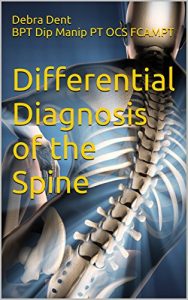A 54-year-old female attends your clinic after suffering a slip and fall at work. She is NWB on her right leg and on crutches. Her pain level is 6/10, 24/7 and is noted in the buttock and she has significant bruising of the entire right thigh anterior and laterally. She has difficulty with transfers in and out of chairs and on and off the bed.
Objectively
Her initial evaluation was markedly limited due to her pain and tolerance.
Standing posture and standing lumbar ROM is limited by her NWB status and crutches
Supine testing:
painful and limited PROM into hip flexion with flexion to 70 degrees/empty endfeel.
Painful but full abduction/adduction
Painful but no limitation of rotations in either direction
SLR is painful at 70 degrees
Femoral nerve test was painful but negative when done in side lie to her tolerance
Myotomes: Painful weakness of L2, L3 with functional strength of L4, L5
Difficulty testing S1 S2
Muscle testing: painful weakness of hip flexors at 2+/5, hip abd 4/5, hip add 4/5
Difficulty testing hip extensors
You treat her for a period of three weeks where she shows notable improvement. Her pain level has dropped to 3/10 in the buttock region but remains 24/7 and worse at night. She is now able to walk without crutches although she has a slight limp. Standing Lumbar ROM was limited into flexion and all other ROM was WNL. Her bruising has cleared well. The strength of her myotomes has improved with the exception of L2 which remains weak and now painless even with repeated testing. She continues to have painful, limited hip flexion and a painful limited SLR at 70 degrees but her hip rotations remain full and relatively pain-free. Muscle testing of her hip muscles, with the exception of psoas, are now WNL.
Take the quiz and see what the problem was.
First of all, no complaints from anyone about the overreacting female. People will often categorize patients when there is a delay in progress that doesn’t follow normal patterns. When this happens, do not assume it is a psychological issue when there may be something more sinister happening.
This case history is another true story in my career. When she arrived at my clinic, she was a straightforward slip and fall with trauma. As she progressed through her treatments, certain objective signs did not change. At four weeks, the slip and fall trauma issues had resolved and she remained with the weak and painless L2. That should be considered a red flag as disc herniations are rare at that level but metastasis may be common. Other issues such as fractures or acute spondylolisthesis were a possibility but she was clear on a repeated x-ray. Hip pathology was ruled out with x-ray, as well as the fact she had full, painless medial rotation at four weeks. Psoas damage may have been another possibility but this is rare. (Dutton, 2004) Her hip flexion and SLR remained limited and painful as well. That should have improved with her treatment by four weeks.
The limitation of hip flexion equal to the limitation of her SLR and the non-limitation of medial rotation is called the Sign of the Buttock. Sign of the buttock was first introduced by James Cyriax in his Textbook of Orthopedic Medicine. It is a combination of seven signs or findings that may indicate serious pathology in the gluteal region posterior to flexion-extension axis of the hip. The pain is nonremarkable and maybe felt in the buttock and down the posterior aspect of the leg to the knee or calf.
If the following seven signs exist, it is considered a red flag and should be referred out for further evaluation.
- trunk flexion is limited to the same extent as hip flexion with other lumbar ROM being full
- hip flexion is limited and more painful than the SLR
- empty endfeel on passive hip flexion
- straight leg raising is limited and painful
- non-capsular pattern of the hip i.e.: medial rotation being of full range instead of limited
- weak and painful resisted hip motion especially extension
- Buttock on examination is larger than the other side, swollen, tender and sometimes increase in warmthover the area
If a straight leg raise is positive and painful but passive hip flexion is full and painless, this is considered a negative. Magee considers if both the straight leg raise and hip flexion are positive for limitation and pain as a positive for the sign of the buttock with a subsequent testing of the pattern of limitation of the hip to be non-capsular.
There are no specific studies on the reliability, sensitivity or specificity of this test.
The various possibilities of pathology that could be the cause of the Sign of the Buttock are:
- osteomyelitis of the upper femur
- chronic septic sacroiliac arthritis
- ischiorectal abscess
- septic bursitis
- rheumatic fever with bursitis
- neoplasm of the upper femur
- iliac neoplasm
- fractured sacrum
This particular patient went on for further testing and was found to have a neoplasm within her right pelvis. We concluded that the initial fall was provoked by the weakness that was developing with the neoplasm. If we had persisted in treating her thinking that she was non-compliant or overreacting or had discharged her without having these particular OBJECTIVE signs correctly evaluated, this would have delayed the correct diagnosis and treatment of this patient.
Cyriax, J. Diagnosis of Soft Tissue Lesions. Volume 1. London: Bailliere Tindall. 1977.
Magee. DJ, Sueki, D. Orthopedic Physical Assessment Atlas and Video: Selected Special Tests and Movements. Elsevier Saunders: st Louis Missouri 2011.
Goodman, C, Kelly Snyder, T. Differential Diagnosis for Physical Therapists.St. Louis: Elsevier, 2013
Pogare, V. Sign of the Buttock. Physio-pedia.com.n.d.web .Jan 17 2016.
Dutton, M. (2004). Orthopaedic examination, evaluation, and intervention. McGraw-Hill.


